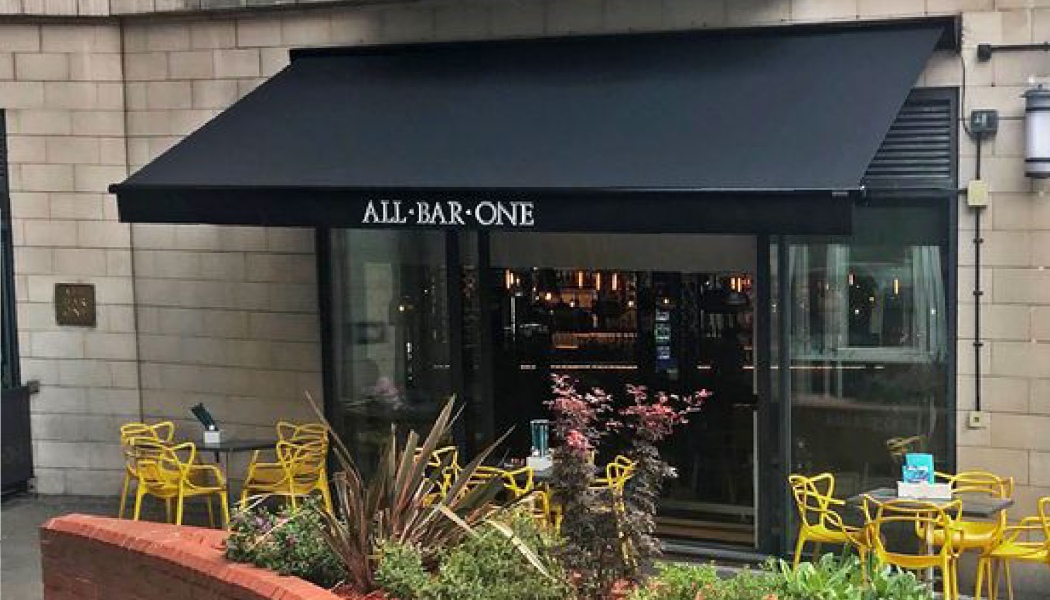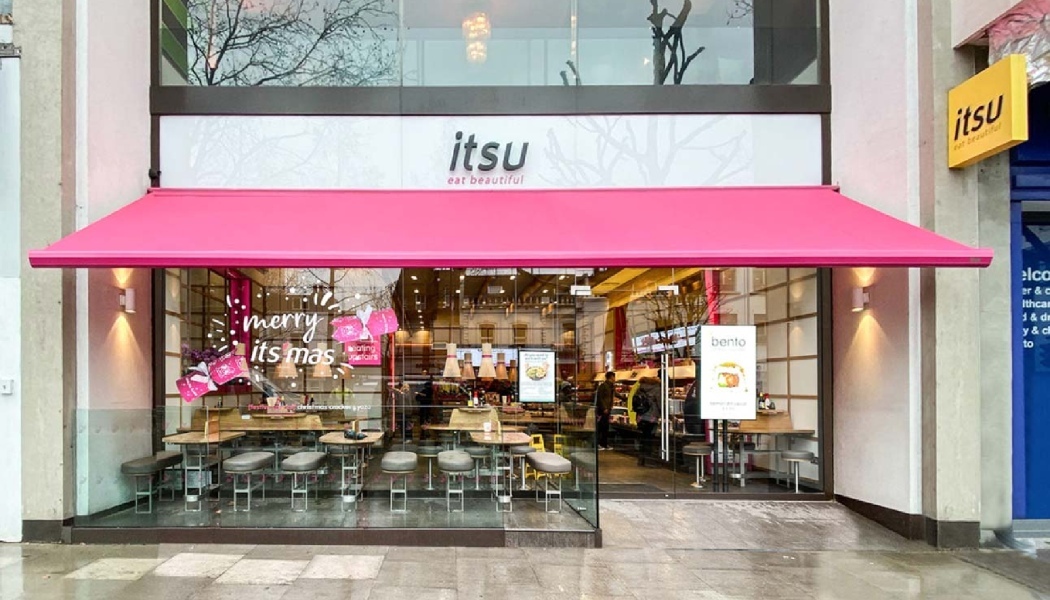Choosing the right fabric for your outdoor awning is a decision of utmost importance, as it directly impacts its functionality and aesthetic appeal. With a multitude of factors to consider, ranging from shade factors to weather resistance, color options to material types, making an informed choice can be daunting.
This guide navigates through options, we explore key considerations like shade factor, weather resistance, and the spectrum of colors and patterns. By understanding these factors, you’ll be able to make an informed decision, ensuring longevity, and effective sun protection for your awning.
Different Types of Awning Fabric Materials
When it comes to selecting the right fabric for your outdoor awning, understanding the unique properties of different materials is imperative.
Natural fabrics, such as cotton, canvas, and wool, offer a traditional and cozy look but are prone to fading, shrinking, and mildewing.
On the other hand, synthetic fabrics like polyester, acrylic, and vinyl are durable, water-resistant, and fade-resistant, making them a popular choice for outdoor awnings. Understanding these factors play a significant role in determining the most suitable awning fabric for your specific needs.
Natural Fabrics
Transitioning into natural fabrics for outdoor awnings, we will focus on three primary materials: canvas, cotton, and wool.
Each of these fabrics brings unique characteristics to the table, including durability, aesthetics, and reactivity to various environmental factors.
It’s essential to understand natural fabrics properties comprehensively, as they directly impact the longevity and overall performance of your outdoor awning.
Canvas
Canvas is a versatile and durable natural fabric that is often used for outdoor awnings. It offers several benefits that make it the right awning fabric choice for many homeowners. Here are three reasons why canvas is a popular option:
- Strength and durability: Canvas is known for its strength and ability to withstand harsh weather conditions, making it a reliable choice for awning fabric replacement.
- Breathability: The natural fibers in canvas allow for air circulation, preventing heat buildup and ensuring a comfortable outdoor space.
- Customization: Canvas can be easily painted or dyed, giving homeowners the flexibility to match their awning fabric with their outdoor design scheme.
With its versatility and durability, canvas is an excellent choice for outdoor awnings. However, it’s important to note that there are other natural fabrics to consider, such as cotton, which we will discuss next.
Cotton
Cotton fabric for outdoor awnings offers a range of benefits, making it a popular choice among homeowners.
Cotton is a natural fabric that is breathable and eco-friendly. It provides good shade and protection from the sun’s rays.
However, cotton is prone to rot, mildew, and fading, so it requires proper maintenance and treatment to ensure durability.
Despite these drawbacks, many people still prefer cotton awnings for their natural and traditional appeal.
Wool
Wool, known for its warmth and insulation properties, is another natural fabric option to consider when choosing materials for your outdoor awning.
- Wool is highly durable and can withstand various weather conditions.
- It offers excellent UV protection, making it ideal for areas with intense sunlight.
- Wool is naturally water-resistant, repelling moisture and preventing mold and mildew growth.
Considering these factors, wool can be a reliable and long-lasting choice for your outdoor awning fabric.
| Fabric | Durability | Maintenance |
|---|---|---|
| Wool | High | High |
| Cotton | Medium | Medium |
| Canvas | Low | Low |
Synthetic Fabrics
When it comes to synthetic fabrics for outdoor awnings, there are several options to consider.
Acrylic-coated polyester is known for being stretch-resistant and weatherproof, while 100% acrylic fabric offers durability and fade-resistance.
Vinyl laminated polyester is immune to mildew and provides UV protection, and solution-dyed acrylic fabric offers better color retention.
Synthetic awning fabrics are generally more durable and resistant to the elements compared to natural materials like canvas, making them popular choices for outdoor awnings.

Acrylic Coated Polyster
Among the synthetic fabrics suitable for outdoor awnings, acrylic-coated polyester stands out for its excellent stretch resistance and weatherproof qualities.
Acrylic-coated polyester is highly durable and can withstand various weather conditions. Despite exposure to sun and rain, it retains its color and structure.
- Stretch resistance: Acrylic coated polyester fabric maintains its shape and structure even when exposed to strong winds or extreme weather conditions.
- Weatherproof: This fabric is designed to withstand rain, snow, and other harsh elements, ensuring that your awning remains intact and protects your outdoor space.
- Long-lasting: Acrylic coated polyester fabric is known for its longevity, allowing your awning to maintain its appearance and functionality for years to come.
- Easy maintenance is another advantage, as it can be cleaned with mild soap and water.
Arcylic Fabric
Polyester and acrylic fabrics are popular choices for outdoor awning materials due to their durability and weather resistance. Polyester fabric, made from petroleum, is known for its strength and longevity. Acrylic fabrics, made from coal or petroleum, are also durable and long-lasting. These synthetic fabrics are more resistant to damage from the elements compared to natural materials like canvas.
Now, let’s explore the next type of synthetic fabric for awnings: vinyl laminated polyester.
Vinyl Lamintaed Polyster
Vinyl laminated polyester is a versatile and popular choice for synthetic awning fabrics due to its durability and resistance to the elements. It is highly durable and can withstand the effects of wind, rain, and sun exposure. Additionally, it offers excellent UV protection, preventing the fabric from fading and deteriorating over time. This type of fabric is also resistant to mold, mildew, and stains, making it easy to clean and maintain.
Now, let’s move on to discussing another popular synthetic fabric option for awnings: solution-dyed acrylic fabric.
Solution-Dyed Acrylic Fabric
When considering different types of awning fabric materials, one popular option to explore is solution-dyed acrylic fabric.
Solution-dyed acrylic fabric is known for its durability and resistance to fading. Unlike canvas, acrylic fabrics can be solution-dyed, resulting in better color retention.
These fabrics are made from coal or petroleum and offer excellent UV resistance, protecting against damage from the sun’s harmful rays.
Solution-dyed acrylic fabric is a high-quality choice for outdoor awnings.
Pros and Cons of Awning Materials
The selection of awning materials involves considering the pros and cons of different options based on factors such as durability, weather resistance, and color variety. When choosing the right awning material for your outdoor space, it is important to weigh the following factors:
- Acrylic fabric is durable and fade-resistant but may not provide the rustic aesthetic that canvas offers.
- Canvas, while offering a natural look, may not hold up well in extreme weather conditions without proper treatment.
- Vinyl is a low-maintenance and weather-resistant option, but may lack the variety in aesthetics that other materials offer.
- Metal and fiberglass awnings provide a modern look and excellent resistance to elements, but may not provide the same level of comfort in terms of heat absorption.
Each material has its own advantages and disadvantages, and it’s important to consider your specific needs and preferences.
Now, let’s move on to the next section where we will discuss popular outdoor awning fabric brands.
Popular Outdoor Awning Fabric Brands
When considering fabric for your outdoor awning, the brand can play a significant role in the fabric’s durability, color retention, and resistance to environmental factors. Some leading brands in the industry, such as Sunbrella, Dickson, Sattler, RECacril, and Para’s Tempotest, have developed innovative materials that offer superior performance in various climates and conditions.
- Sunbrella is known for its long-lasting color, excellent UPF protection, and recognition from the Skin Cancer Foundation.
- Dickson offers fade-resistant, UV, water, and stain-resistant fabrics that are easy to clean.
- Sattler provides UV-resistant fabrics with UPF protection and water repellency.
- RECACRIL-House Brand is tightly woven, tear-resistant, antimicrobial, UPF rated, and easy to maintain.
- PARA TEMPOTEST-House Brand offers shade protection with added TeflonExtreme for resistance to dirt, water, and oil.
Sunbrella
Sunbrella is a well-known brand that offers solution-dyed fabrics, providing long-lasting color and exceptional UPF protection for outdoor awnings.
When considering Sunbrella as an option for your outdoor awning fabric, here are three key points to keep in mind:
- Durability: Sunbrella fabrics are known for their durability and resistance to fading, making them ideal for outdoor use. They are made with solution-dyed acrylic fibers that retain their color even after prolonged exposure to sunlight.
- UV Protection: Sunbrella fabrics offer excellent UPF (Ultraviolet Protection Factor) protection, blocking out harmful UV rays and providing a safe and shaded environment.
- Variety of Colors and Patterns: Sunbrella fabrics come in a wide range of colors and patterns, allowing you to choose the perfect design that complements your outdoor space.
With its long-lasting color, UV protection, and variety of options, Sunbrella is a popular choice for outdoor awning fabrics.
Dickson
As one of the popular outdoor awning fabric brands, Dickson offers a wide range of durable and high-quality fabrics for various outdoor applications.
Dickson is known for its innovative and advanced solutions in awning fabrics. Their fabrics are designed to withstand harsh weather conditions, including wind, rain, and intense sunlight.
Dickson fabrics are made using solution-dyed acrylic, which provides excellent color retention, water resistance, and UV protection. The solution-dyeing process ensures that the color penetrates deep into the fabric, making it highly fade-resistant.
Additionally, Dickson fabrics are easy to clean and maintain, making them ideal for outdoor awnings.
With their commitment to quality and performance, Dickson is a trusted choice for those seeking long-lasting and reliable awning fabrics.
Sattler
Sattler is a popular brand of outdoor awning fabric known for its fade-resistant properties and water repellency. When it comes to choosing the right fabric for your outdoor awning, Sattler offers several advantages that make it a top choice for many homeowners. Here are three reasons why Sattler fabric stands out:
- Fade Resistance: Sattler fabrics are specially designed to resist fading, even when exposed to harsh sunlight for extended periods. This ensures that your awning will maintain its vibrant color and appearance for years to come.
- Water Repellency: Sattler fabrics are treated with water repellent coatings, making them highly resistant to water penetration. This means that your awning will remain dry and protected during rain showers or other wet weather conditions.
- Durability: Sattler fabrics are known for their durability and ability to withstand the elements. They are made from high-quality materials that are designed to resist tearing, stretching, and other forms of damage, ensuring that your awning will last for a long time.
With its fade-resistant properties, water repellency, and durability, Sattler fabric is an excellent choice for your outdoor awning needs.
RECACRIL-House Brand
Next on the list, and equally noteworthy, is RECACRIL, a house brand that has made a significant impact in the outdoor awning fabric industry. This brand is renowned for its tightly woven, tear-resistant fabrics which offer excellent protection against environmental factors. Its antimicrobial properties prevent the growth of mold and mildew, ensuring long-lasting use. Furthermore, RECACRIL fabrics are UPF rated, offering high UV protection which is crucial in maintaining the fabric’s vibrant colors and longevity.
The brand’s commitment to durability and quality is reflected in their fabrics’ ability to withstand varying weather conditions.
The next section will delve into another popular awning fabric brand, Para Tempotest, which offers its own unique advantages in outdoor awning fabric choices.
PARA TEMPOTEST-House Brand
While RECACRIL offers an impressive range of durable fabrics, it is essential to consider PARA TEMPOTEST, another notable house brand that has carved its niche in the outdoor awning fabric market. This brand is well-known for its time and weather-tested fabrics that provide exceptional durability and resilience even in harsh environmental conditions.
- PARA TEMPOTEST fabrics are highly resistant to water, dirt, and oil due to their Teflon Extreme finish.
- They are designed to withstand prolonged exposure to sunlight, maintaining their vibrant color and structural integrity over time.
- These fabrics are also resistant to mold and mildew, making them a practical choice for outdoor use.
- PARA TEMPOTEST offers a wide range of stylish designs and color options, allowing for a perfect blend of functionality and aesthetics.
9 Points to Consider Before Choosing Fabric for Your Awning
When considering fabric for your outdoor awning, several key factors should be kept in mind. These include:
- The fabric’s capacity to be cleaned
- Its durability
- Its resistance to UV and sunlight
- Its waterproofing capabilities
Additionally, the adjustability of the awning itself can also play a significant role in your final choice.

Cleanable Fabrics
Considering the importance of maintenance in prolonging the life of your outdoor awning, selecting a fabric that is easy to clean should be a key factor in your decision-making process. Amidst various fabric options, some are more amenable to cleaning than others.
Here are some points to consider:
- Woven polyester coated with PVC is not only durable and waterproof, but it also offers the advantage of being easy to clean.
- Acrylic-coated polyester materials are not only stretch-resistant and weatherproof, but also simplify the cleaning process.
- Some fabrics are machine washable, making them highly convenient for regular maintenance.
- Regardless of fabric choice, be sure to follow manufacturer instructions for cleaning and maintenance to ensure longevity and durability.
UV and Sunlight Protection
To ensure optimal protection against harmful UV rays and sunlight, it is imperative to carefully select the right fabric for your awning. UV radiation from the sun is the main cause of damage to awning fabrics, which can lead to fading, deterioration, and reduced lifespan.
When choosing an awning fabric, look for materials that offer high levels of UV resistance. Fabrics certified to UV Standard 801 provide excellent UV protection. Some popular options include OBravia and Sunbrella, which are known for their UV-resistant properties.
Additionally, consider the color of the fabric, as darker colors tend to offer better UV protection. By selecting a fabric with adequate UV resistance, you can ensure that your awning will provide long-lasting protection against the sun’s harmful rays.
| Fabric Type | UV Protection Level | Durability |
|---|---|---|
| Cotton Canvas | Low | Low |
| Acrylic | High | High |
| Vinyl Laminated Polyester | High | High |
Waterproof
The waterproof feature is an important consideration when choosing fabric for your awning. Here are three points to consider before making your selection:
- Water-resistant fabrics guard against damage caused by humidity and precipitation, particularly vital in tropical or damp climates.
- Materials like vinyl laminated polyester and PVC coated polyester offer robust water resistance, safeguarding your awning from mildew and rot.
- Apart from material, consider awning designs that effectively repel water, preventing pooling that can accelerate wear and tear.
- Lastly, remember to balance water resistance with other critical features such as UV protection, durability, and aesthetic appeal.
Adjustability
Consider the adjustability of your awning fabric to ensure flexibility in placement and usage. Adjustable awnings provide the convenience of being able to control the amount of shade or sunlight that enters your outdoor space. They allow you to customize the coverage based on the time of day or changing weather conditions.
When choosing fabric for your awning, look for materials that are easy to adjust and maintain their shape when extended or retracted. Coated polyesters are known for their durability and protection against the elements, making them a good option for adjustable awnings. Consulting our experts or relying on customer reviews can also help you find recommendations for durable awning brands.
| Considerations | Non-Adjustable Awnings | Adjustable Awnings |
|---|---|---|
| Placement Flexibility | Fixed, limited adjustment | High, can adapt to changing conditions |
| Weather Resistance | Dependent on fabric | High, choice of fabric crucial |
| Durability | Varies with fabric | Enhanced with right fabric |
| UV Protection | Fabric-dependent | Essential, given exposure variability |
Durability
Ensuring durability is a paramount consideration when selecting the fabric for your awning, as it directly impacts the lifespan and performance of the product. Durability pertains to the fabric’s ability to withstand the elements, maintain its color, and resist wear and tear.
Consider the following points before making a choice:
- Material composition: Fabrics like acrylic-coated polyester and PVC-coated woven polyester are known for their durability.
- Weather resistance: The fabric should be able to endure environmental conditions specific to your area, like intense sun, high humidity, or heavy rainfall.
- Maintenance: Durable fabrics are often easy to clean, extending the awning’s lifespan.
- Warranty: A good warranty could indicate a manufacturer’s confidence in the durability of their product.
Choose wisely to ensure your awning serves its purpose for years to come.
Weather Conditions
Taking into account the local weather conditions is a crucial step before choosing fabric for your awning, as it significantly impacts the durability and functionality of the material. Certain materials like acrylic-coated polyester and PVC-coated polyester are weatherproof and durable, making them ideal for areas with harsh weather conditions. These fabrics resist stretching, fading, and water damage.
For tropical climates with high humidity and rainfall, water-resistant fabrics are essential. Cotton canvas, while eco-friendly, may not be the best choice in such conditions due to susceptibility to rot and mildew.
Ensure your awning can withstand local wind strengths and UV exposure levels. Some materials offer UV protection, safeguarding your outdoor space from harmful rays. Always consider your specific geographical and climatic conditions before making a selection.
| Awning Fabric Material | Weather Resistance | Water Resistance |
|---|---|---|
| Cotton Canvas | Prone to rot, mildew, and fading | Not water resistant |
| Acrylic-coated Polyester | Weatherproof and stretch-resistant | Water resistant |
| 100% Acrylic | Durable and fade-resistant | Water resistant |
| Vinyl Laminated Polyester | Immune to mildew, UV protection | Water resistant |
| Woven Polyester coated with PVC | Durable, waterproof, and easy to clean | Water resistant |
Consider these factors when choosing fabric for your outdoor awning to ensure its longevity and performance in various weather conditions.
Geographical Climate
Understanding the specific geographical climate of your area is a critical factor when choosing the right fabric for your outdoor awning. This is because different climates require different fabric properties to ensure longevity and functionality of the awning.
Here are some points to consider:
- Temperature extremes: If you live in an area with extreme hot or cold temperatures, choose a fabric that is resistant to fading, cracking, and deterioration.
- Humidity levels: In humid climates, opt for a fabric that is resistant to mold and mildew growth. This will ensure that your awning remains clean and free from any unpleasant odors.
- Rainfall and precipitation: If you live in an area with frequent rainfall, select an awning fabric that is waterproof and can withstand heavy downpours without getting damaged. This will prevent water from seeping through and potentially causing damage to your outdoor space.
Maintenance
Different materials have different maintenance needs, so it’s essential to understand how much time and effort you are willing to invest in keeping your awning in good condition.
For example, cotton canvas awnings are eco-friendly but prone to rot, mildew, and fading, requiring regular cleaning and treatment.
On the other hand, acrylic-coated polyester materials are stretch-resistant and weatherproof, making them easier to maintain. Additionally, 100% acrylic fabric is durable, fade-resistant, and often comes with a 10-year guarantee, providing peace of mind and reducing the need for frequent maintenance.
Consider your maintenance preferences and capabilities before choosing the fabric for your outdoor awning.
Warranty
When you’re about to settle on a particular fabric for your outdoor awning, it’s crucial to factor in the warranty provided by the manufacturer, as it can significantly impact the overall value and longevity of your investment.
- Coverage: Ensure the warranty covers both material and workmanship defects. Some warranties may only cover the fabric, leaving out crucial components like frames and hardware.
- Duration: The length of the warranty period can vary between manufacturers. Opt for long-term warranties for more value.
- Transferability: Some warranties may be transferable to a new owner if you sell your property, enhancing the resale value.
- Claim Process: Understand the procedure for making a claim. Some may require professional installation for the warranty to be valid. Always keep your purchase receipt and a copy of the warranty.
How to Pick the Right Fabric for Outdoor Awnings
Regularly assessing the factors such as durability, shade factor, weather resistance, and aesthetic appeal can significantly help in picking the right fabric for your outdoor awnings.
Consider fabrics like acrylic, polyester, and vinyl-coated, known for their durability and weather resistance. Acrylic fabrics, for instance, resist fading and mildew growth, making them ideal for humid climates. Polyester, a synthetic fabric, is stretch-resistant and weatherproof, suitable for areas with variable weather conditions.

The shade factor, a measure of how much sunlight a fabric blocks, varies among materials. Fabrics with a high shade factor, such as AwnTex, can block up to 88% of the sun’s rays.
Lastly, consider the aesthetic appeal. The right awning fabric should not only be functional but also complement your home’s exterior design.
Why the Fabric of an Awning Matters so Much
Although many may overlook this fact, the fabric of an awning plays a critical role not just in its aesthetic appeal, but also in its durability, functionality, and overall performance against various weather conditions. This is due to several factors:
- Material Composition: The fabric’s material, whether natural like canvas or synthetic such as polyester or acrylic, directly influences its durability and weather resistance.
- UV Resistance: Fabric that is resistant to ultraviolet rays prevents premature fading and deterioration, thereby extending the lifespan of the awning.
- Solution Dyeing: This process infuses color into the fabric before finishing, resulting in superior colorfastness.
- Care and Maintenance: Regular cleaning and occasional retreatment can significantly prolong the life of the fabric, thereby enhancing the overall performance of the awning.
Reach Out to Signs New York for Outdoor Awnings
To get the best outdoor awnings for your property, reach out to Signs New York, a trusted provider of high-quality awnings. With our expertise and experience, we can help you choose the perfect fabric for your outdoor awning.
At Signs New York, we offer a wide range of options, including canvas, polyester, and acrylic fabrics, each with its own unique features and benefits. To make the decision-making process easier, here is a table outlining the key characteristics of these materials:
| Material | Durability | Fade Resistance | Water Repellency |
|---|---|---|---|
| Canvas | Moderate | Moderate | Low |
| Polyester | High | High | High |
| Acrylic | High | High | High |
Don’t compromise on your outdoor comfort and aesthetics; let Signs New York help you choose the ideal awning fabric.
Frequently Asked Questions
What Is the Average Lifespan of Various Awning Fabric Materials?
The lifespan of awning fabric depends on the material and environmental exposure.
Canvas, though eco-friendly, is prone to rot, mildew, and fades faster, averaging a lifespan of 5-7 years.
Acrylic-coated polyester is more durable, lasting about 10 years.
High-quality acrylic fabric and vinyl laminated polyester can last up to 10-15 years, offering fade-resistance and UV protection.
Are There Any Eco-Friendly Fabric Options for Outdoor Awnings?
Yes, there are several eco-friendly fabric options for outdoor awnings.
One such option is recycled polyester, which is durable and resistant to weather conditions.
Another choice is a natural fiber like cotton, which is biodegradable, though less durable.
Additionally, solution-dyed acrylics, while not made from recycled materials, have a long lifespan that reduces replacement and waste.
It’s important to balance environmental considerations with durability and maintenance needs when choosing awning fabric.
Can Awning Fabrics Be Custom Printed With Logos or Designs?
Yes, awning fabrics can indeed be custom printed with logos or designs. This feature allows businesses and homeowners to personalize their outdoor spaces.
However, it’s crucial to select a high-quality fabric that can withstand weather conditions and maintain the vibrancy of the printed design. Some materials, such as the Patio 500 fabric line, are particularly suitable for silk-screen printing.
Ultimately, the choice of fabric should balance aesthetics, durability, and functionality.
How Does the Weight of the Awning Fabric Affect Its Durability and Functionality?
The weight of the awning fabric significantly impacts its durability and functionality. Heavier fabrics typically offer greater strength and longevity, making them suitable for areas with harsh weather conditions. However, they may require stronger support structures.
Lighter fabrics, while easier to handle and install, might not withstand extreme weather as effectively. Therefore, when choosing an awning fabric, it’s important to consider both the weight and the specific environmental conditions it will be exposed to.
Are There Any Specific Fabric Treatments to Increase the Fire Resistance of Awning Materials?
Yes, specific fabric treatments can indeed enhance the fire resistance of awning materials. These treatments coat or impregnate the fabric with flame-retardant substances, reducing its flammability.
It’s crucial to note that while such treatments increase fire resistance, they do not make the material completely fire-proof.
The effectiveness of these treatments can vary, and they may need to be reapplied over time to maintain their protective properties. Therefore, careful consideration should be given to material choice in fire-prone areas.
